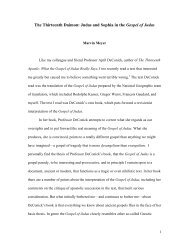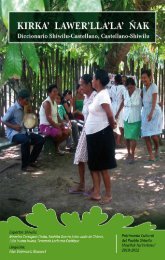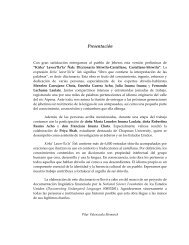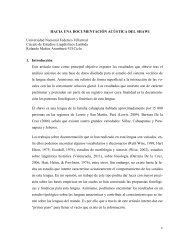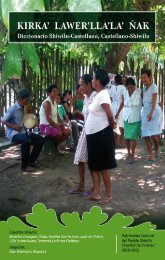“Surplus Humanity” and the Margins of Legality - Chapman University
“Surplus Humanity” and the Margins of Legality - Chapman University
“Surplus Humanity” and the Margins of Legality - Chapman University
Create successful ePaper yourself
Turn your PDF publications into a flip-book with our unique Google optimized e-Paper software.
Do Not Delete 12/12/2010 7:34 PM<br />
6 <strong>Chapman</strong> Law Review [Vol. 14:1<br />
household <strong>of</strong> six people into fifteen square meters, with a latrine<br />
usually shared by six families. 29 Pavement <strong>and</strong> sidewalk<br />
dwellers in Mumbai reach approximately one million. 30 Of <strong>the</strong>se,<br />
seventy percent have been in <strong>the</strong> city for at least six years, <strong>and</strong><br />
one-third have been evicted from a chawl or a slum. 31 While<br />
Mumbai‘s estimated annual housing deficit <strong>of</strong> 45,000 units<br />
translates into a corresponding increase in slum dwellings,<br />
400,000 units lie empty because owners loath <strong>the</strong> m<strong>and</strong>ated<br />
regime <strong>of</strong> fixed rents <strong>and</strong> <strong>the</strong> resulting propensity <strong>of</strong> tenants to<br />
become permanent occupiers. 32 Homelessness <strong>and</strong> slum growth<br />
in Mumbai is directly related to job losses associated with<br />
industrial restructuring. In 1921, textile mills hired 16.2% <strong>of</strong> <strong>the</strong><br />
males <strong>and</strong> 9.5% <strong>of</strong> <strong>the</strong> females <strong>of</strong> <strong>the</strong> city‘s population. 33 In 1931,<br />
<strong>the</strong> Census Commissioner stated that ―‗[s]ave for its textile<br />
manufacture‘, . . . ‗Bombay has really little claim to be called an<br />
industrial city. . . .‘.‖ 34 Until 1980, 250,000 textile mill workers<br />
lived in Mumbai; today <strong>the</strong> number has fallen below 30,000. 35<br />
This is part <strong>of</strong> a broader contraction <strong>of</strong> <strong>the</strong> formal sector <strong>of</strong> <strong>the</strong><br />
economy that has forced <strong>the</strong> urban poor to fend for <strong>the</strong>mselves in<br />
<strong>the</strong> so-called informal sector.<br />
Life in Dharavi demonstrates that, for <strong>the</strong> urban poor,<br />
housing is a verb. 36 Dharavi, a 175-hector (0.67 square miles)<br />
maze <strong>of</strong> dark alleys <strong>and</strong> corrugated shacks, compacts 18,000<br />
people per acre into 10-by-15 foot rooms stacked on top <strong>of</strong> one<br />
ano<strong>the</strong>r. 37 Here, slum-dwellers juggle housing cost, tenure<br />
security, quality <strong>of</strong> shelter, distance from work, <strong>and</strong> personal<br />
safety. Even pavement-dwelling, much less an extra-legal shack,<br />
is not free; regular fees have to paid to <strong>the</strong> police, crime<br />
29 ALAIN R.A. JACQUEMIN, URBAN DEVELOPMENT AND NEW TOWNS IN THE THIRD<br />
WORLD: LESSONS FROM THE NEW BOMBAY EXPERIENCE 89 (1999).<br />
30 Minar Pimple & Lysa John, Security <strong>of</strong> Tenure: Mumbai‘s Experience, in HOLDING<br />
THEIR GROUND: SECURE LAND TENURE FOR THE URBAN POOR IN DEVELOPING COUNTRIES<br />
75, 76, 78 (Alain Dur<strong>and</strong>-Lasserve & Lauren Royston eds., 2002).<br />
31 JACQUEMIN, supra note 29, at 90.<br />
32 SUKETU MEHTA, MAXIMUM CITY: BOMBAY LOST AND FOUND 117 (2004).<br />
33 R. CHANDAVARKAR, THE ORIGINS OF INDUSTRIAL CAPITALISM IN INDIA: BUSINESS<br />
STRATEGIES AND THE WORKING CLASSES IN BOMBAY, 1900–1940 77 (1994).<br />
34 Id.<br />
35 Sharit K. Bhowmik, The Politics <strong>of</strong> Urban Space in Mumbai: ‗Citizen‘ versus <strong>the</strong><br />
Urban Poor, in CONTESTED TRANSFORMATIONS: CHANGING ECONOMIES AND IDENTITIES IN<br />
CONTEMPORARY INDIA 149, 151 (Mary E. John et al. eds., 2006) [hereinafter CONTESTED<br />
TRANSFORMATIONS]. The decline <strong>of</strong> <strong>the</strong> textile industry in Mumbai resulted from <strong>the</strong><br />
global shift <strong>of</strong> textile production to comparatively low-wage settings like Bangladesh,<br />
China, <strong>and</strong> Vietnam. See Sanjaya Lall, India‘s Manufactured Exports: Comparative<br />
Structure <strong>and</strong> Prospects, 27 WORLD DEV. 1769, 1769–70 (1999).<br />
36 John F. C. Turner, Housing as a Verb, in FREEDOM TO BUILD: DWELLER CONTROL<br />
OF THE HOUSING PROCESS 148, 151 (John F. C. Turner & Robert Fichter eds., 1972).<br />
37 KALPANA SHARMA, REDISCOVERING DHARAVI: STORIES FROM ASIA‘S LARGEST SLUM<br />
18 (2000).




